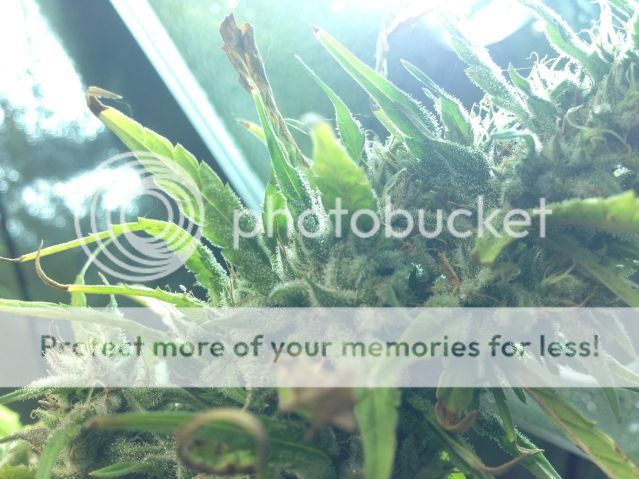240 Watts All White LED Grow Northern Lights
- Thread starter trueg115
- Start date
brotherjericho
Well-Known Member
So how was the penetration using 90 deg lens? And how close can you get the plant without bleaching? I'm seriously considering speccing an Apollo light.They are each set at 90 degress, enough to get good penetration yet spread the lights out for a mix of color.
Thanks!
trueg115
Well-Known Member
I could get my plants anywhere without touching them without leaching. Once they touched, they leached and browned. So penetration was good, but remember this is only white. I didnt get to see too much penetration as time went on since it was pretty crowded the whole grow but quite a bit of the plant is receiving light.
I would suggest you to add one or two NW instead of so many 6500k
I would suggest you to add one or two NW instead of so many 6500k
brotherjericho
Well-Known Member
I'm looking for a flower only lamp, so going to focus mostly on 2700k-3000k for my LEDs, but will try to balance it out and get it close to 10% blue.
brotherjericho
Well-Known Member
What benefit would neutral give me over focusing on just warm for a bloom light? Seems it would up the green a bit. I was considering mostly WW and some 630nm or 660nm (if they are available).
trueg115
Well-Known Member
It has been shown that blue light during flowering is beneficial to the plant so it helps growth overall. There are still processes used in flowering that use blue light, just at a much smaller amount then red and orange light during flowering. As hyroot said, WW and NW will supply plenty of blue. I personally used so much cool light because I wanted to veg as well with it
Bilbo Baggins
Well-Known Member
Calyx's swelling noticeably now trueg, only days away by the look of things
trueg115
Well-Known Member
That is plant # 2, of which is predominately Indica, so i am actually cutting it tonight. In need of medicine and there is plenty more colas on the other two plants to do so. I only have 4 weeks left until the move anyways and want to get the rest of the plants with as much light coverage as possible.
hyroot
Well-Known Member
I like the close up pics. That looks bomb. The one with the bird cage looks like lettuce and guacomole. Lol I know its the camera. My camera sucks too. Mine wont even zoom in or out.Try putting it to black or dark background when you take a pic. It really makes it pop. If you have seen nugbuckets pro photography studio set up for his plants.
PetFlora
Well-Known Member
Maybe the white haters can't bring themselves to believe awesome buds can be grown under white only ledsIt starts getting good and everyone dissapears haha
I know I get my share of doubters
brotherjericho
Well-Known Member
I don't know that there are white haters, just many who don't see the point. If I want a mix of WW, CW, NW, etc. I can do that with fluorescent already, and at a much lower price up front. What do you believe LED whites have to offer that can't be accomplished with regular 3000k, 5000k, and 6500k fluouro t5 or PLL?
hyroot
Well-Known Member
those flourescent are not the same as led in spectrum not even close. they are tri phosphor. only having 3 spikes 1 blue, 1 red, and 1 green all in the wrong places. they are not full spectrum at all. kelvin is no way to be measuring spectrum. its based on black body radiator temperature scale.
this is a typical 6500 k t5

this is a 6000k from cidly'

see the difference. t5 kelvin bulbs doesn't cover shit where led does
here is an aquarium t5 spectrum not kelvin rated. flora sun
View attachment 2715593
the better the spectrum and more red they have the less they last. they start degrading after 6 months . they last 8 months to 1 year. so led in the long run is cheaper.
this is a typical 6500 k t5

this is a 6000k from cidly'

see the difference. t5 kelvin bulbs doesn't cover shit where led does
here is an aquarium t5 spectrum not kelvin rated. flora sun
View attachment 2715593
the better the spectrum and more red they have the less they last. they start degrading after 6 months . they last 8 months to 1 year. so led in the long run is cheaper.
PetFlora
Well-Known Member
Not if they are built into a fixture that is not user friendly to replace the 660s. Advantage LED tubes, Agro makes a 660 $71those flourescent are not the same as led in spectrum not even close. they hare tri phosphor. only having 3 spikes 1 blue, 1 red, and 1 green all in the wrong places. they are not full spectrum at all. kelvin is no way measuring spectrum. its based on black body radiator temperature scale.
this is a typical 6500 k t5
View attachment 2715590
this is a 600k from cidly'
View attachment 2715591
see the difference. t5 kelvin bulbs doesn't cover shit where led does
here is an aquarium t5 spectrum not kelvin rated. flora sun
View attachment 2715593
the better the spectrum and more red they have the less they last. they start degrading after 6 months . they last 8 months to 1 year. so led in the long run is cheaper.















